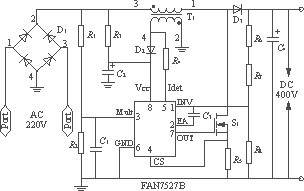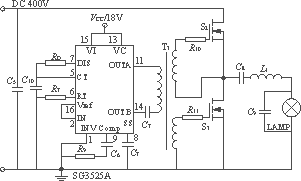Abstract: An efficient and reliable high-pressure sodium lamp electronic ballast based on variable frequency control is developed. The design of frequency modulation technology eliminates acoustic resonance, and simple and reliable resonant start circuit and overcurrent, overvoltage and abnormal protection circuits. .
Key words: high pressure sodium lamp; acoustic resonance; frequency modulation; series resonance
CLC number: Document code: Article number:
This article refers to the address: http://
0 Preface
High-pressure sodium lamp (HPSL) is a high-performance gas discharge lamp (HIDL) with excellent performance. It has the advantages of high light efficiency, long life and good light color, so it is widely used. Like all gas discharge electric light sources, high pressure sodium lamps have a negative V-I characteristic, requiring a ballast to suppress the lamp current, and requires a gas breakdown voltage of 5 to 20 kV at startup. Traditional magnetic ballasts are bulky, have low power factor (only 0.3 to 0.4), and are not adaptable to grid voltage fluctuations. Therefore, the development of cost-effective electronic ballasts to replace magnetic ballasts is The trend of the times. The high-pressure sodium lamp electronic ballasts that have been developed are mostly high-frequency electronic ballasts. In the high-frequency state, the high-pressure sodium lamps are easy to extinguish the arc, and there is an acoustic resonance problem. In order to avoid acoustic resonance, the 600W high-pressure sodium lamp high-frequency electronic ballast has been developed using frequency modulation technology, so that the current operating frequency of the high-pressure sodium lamp changes around the center frequency. The startup part uses an LC series resonant circuit to generate high voltage, which is simple and reliable.
1 overall control strategy
The circuit block diagram is shown in Figure 1. The main circuit is divided into two stages, the first stage is a rectification and active power factor correction circuit (APFC), and the second stage is an inverter circuit. It can be seen that the electronic ballast is essentially a typical AC/DC/AC conversion circuit. The auxiliary power supply consists of a single-ended flyback power supply consisting of UC3844 , and the output voltage is 18V to power the chip.
Figure 1 Overall structure of the 600W electronic ballast
2 rectification and APFC parts
The AC is rectified by a diode. Although the input voltage is sinusoidal, the input current is severely distorted and the efficiency is very low. A large amount of use will cause serious harm to the power grid, and the noise generated by the input current harmonics will also affect the operation of the circuit. APFC can increase the input power factor of the circuit to above 0.95, so that the input current is basically sinusoidal, and the harmonic content is greatly reduced. In this paper, the Boost circuit controlled by FAN7527B is used as the APFC circuit as shown in Figure 2. The FAN7527B is a simple and efficient power factor corrector from Fairchild Semiconductor that includes an R/C filter, so the peripheral circuitry does not require an R/C filter. The secondary side of the transformer T1 has two functions: to supply power to the chip and as a detection signal for current zero crossing. The chip uses voltage and current double closed loop control, and the inner loop uses current interrupted indefinite frequency mode control. The voltage detection signal (pin 1) and the synchronization signal (pin 3) are multiplied as a current reference, and R5 is a current detection resistor. The output voltage can be controlled over a wide range. According to the requirements of the latter stage, the control is at 400V, as shown in Figure 2.

Figure 2 Rectifier and APFC schematic
3 high frequency half bridge inverter part
High-frequency inverter is an important part of high-pressure sodium lamp electronic ballast. It adopts the half-bridge inverter variation form and uses less two capacitors. The structure is simple and the cost is saved. Only the output voltage of the circuit is half of the full bridge. Under the same output power condition, the power tube current of the half bridge is twice as large as that of the full bridge. Considering the normal working voltage of the high pressure sodium lamp, the half bridge circuit can fully meet its requirements. As shown in Figure 3, the working process is that the inductors L1 and C9 first reach the series resonance, the frequency is 200kHz, and the high voltage of 7kV is generated, so that the high-pressure sodium lamp is ignited. After the ignition, the high-pressure sodium lamp is turned on, and C9 does not work, because C8>>C9, C8 and the inductor do not resonate, which acts as a ballast. At this time, the frequency fluctuates up and down in the range of 2 kHz centering on 35 kHz. After 1 min, the high pressure sodium lamp reaches a constant power and normal operation. The half-bridge output square wave becomes a high-frequency alternating current after being ballasted by C8 and L1.
As shown in Figure 3, the half-bridge driver chip adopts the voltage-type PWM controller SG3525A produced by American Silicon Technology Co., Ltd., which is a monolithic integrated PWM controller with excellent performance, complete functions and strong versatility. The chip is simple and reliable, and is easy to use and flexible. Through appropriate external circuits, it can not only realize PWM control, but also complete various functions such as input soft start, overload current limit, over voltage protection, dead zone adjustment and so on. The working principle is that two complementary PWM driving pulses outputted by the triggering pulse transformer T3 are sent to the gates of the switching tubes S2 and S3 to control the two power tubes to work alternately. The oscillator in the SG3525A is externally connected to the time-scale capacitor CT, which provides a discharge path through the resistor RD. Changing the value of RD can change the discharge time of the CT and change the dead time. The CT charging current is determined by the current source specified by RT, and the foot 8 of the SG3525A acts as an input soft start. The oscillation frequency of SG3525A is f = 1 / [CT × (0.7RT + RD)].

Figure 3 Half-bridge high-frequency inverter circuit
4 suppression of acoustic resonance
When the HPSL is ignited by the high-frequency power source, the pulsation of the pressure wave in the tube is reflected back from the inner wall of the tube, and if the phase of the pulsating component of the high-frequency current of the lamp is the same, a standing wave is formed to generate an acoustic resonance. As long as the operating frequency of the ballast is the same as one of the acoustic oscillation frequencies, it is possible to generate acoustic resonance.
Studies have shown that acoustic resonance is easy to occur in the frequency range of 8 kHz to 150 kHz. For this reason, the suppression of acoustic resonance has proposed many methods in foreign literature, such as DC superposition method, periodic commutation method and frequency conversion modulation method, but it cannot be put into mass production due to complicated circuit and increased cost. At the appropriate high frequency, the frequency modulation driving technology is a simple and practical new technology, which works well in eliminating the acoustic resonance phenomenon in the electronic ballast of the high-pressure sodium lamp.
As shown in Figure 4, this experiment uses a 555 timer to form a multivibrator, which emits a square wave with a frequency of 2 kHz, which causes S4 to be continuously turned on and off, causing the level of the foot 6 of the oscillator of the SG3525A to change. As a result, the operating frequency of the ballast changes around the center frequency (35 kHz). Sometimes, even if the frequency of the audible oscillation is encountered, the frequency changes due to the fact that it is too late to form a standing wave, thus avoiding acoustic resonance.
Figure 4 Schematic diagram of the suppression of acoustic resonance
5 Experimental results
According to the above design, the experimental high pressure sodium lamp model is NG400, and the digital storage oscilloscope model is DS-5000 series. As shown in FIG. 5, the startup voltage is 7 kV, and the pulse width is 0.2 μs or less. Figure 6 shows the voltage and current output waveforms of the high-pressure sodium lamp during normal operation. Channel 1 is the voltage output waveform, and channel 2 is the current output waveform. The effective voltage value is 128V, the current maximum value is 9.8A, and the effective value is 4.7A.
Figure 5 high pressure sodium lamp start waveform
Figure 6 Voltage and current output waveform of high pressure sodium lamp during normal operation
6 Conclusion
The experimental results of the 600W solar high-pressure sodium lamp electronic ballast show that the circuit works stably, the frequency modulation technology is used to eliminate the acoustic resonance, the constant power control is basically realized, and the high-pressure sodium lamp is reliable and stable, indicating that the relevant technical requirements are met, and the circuit is started. Fast, simple and reliable.
Hot Materials·Development of 600W High Pressure Sodium Lamp Electronic Ballast
· An analog control car headlight electronic ballast
· Research on a digital low-power metal halide lamp electronic ballast
· Development of an active power factor corrector
· Intelligent lighting system for teaching building based on CAN/LIN bus
· Electro-optic modulation system design








